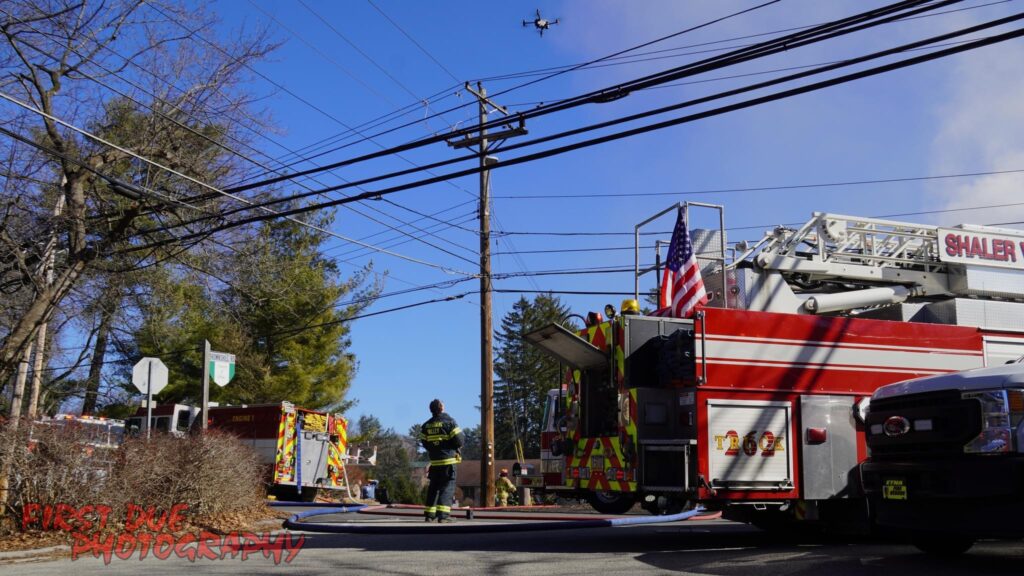Drones have quickly become indispensable tools for firefighting and search & rescue (SAR). In fact, among public safety agencies using drones, fire departments are the second most common users after police. And it’s no wonder – a drone provides an instant aerial perspective that can greatly improve situational awareness in emergencies. Firefighters now launch drones to size-up large fires, spot hidden hotspots with thermal cameras, and even deliver life jackets or medical supplies in rescue scenarios where humans can’t reach quickly.

Firefighting Applications: At structure fires, incident commanders use drones to get eyes on the roof and upper floors that crews on the ground can’t see. For example, the New York City Fire Department (FDNY) has a dedicated Robotics Unit with tethered drones; the drone’s live video helped FDNY chiefs see when a roof was on the verge of collapse during a 4th-alarm fire, prompting an evacuation and ultimately keeping members safe. Drones equipped with thermal imaging are game-changers – they can detect fire extension or smoldering hotspots through smoke and walls. This allows firefighters to direct their efforts more effectively, extinguishing hidden fire and preventing flare-ups. In wildfire operations, drones monitor the fire’s spread and scan for spot fires that incident command doesn’t yet know about. They can fly at night when manned helicopters are largely grounded, using infrared to guide overnight crews. Fire departments like in South Metro, Colorado use drone thermal views to track wildfire progress and even to overwatch crews’ safety, seeing what the human eye cannot in the dark or through thick smoke.
Search & Rescue: For missing persons or disaster victims, drones drastically cut search times. A drone can cover in minutes an area that would take a ground team hours to traverse. Outfitted with thermal cameras, they pick up the infrared signature of a lost hiker or injured survivor even in dense brush or low light. Globally, drones have directly saved over 1,000 people by finding missing individuals or delivering crucial aid. In one case, a drone in Canada located an unconscious car crash victim in a snowy field at night – something nearly impossible for responders on foot. Drones have delivered life jackets to swimmers in distress and ropes to stranded flood victims. After hurricanes and earthquakes, agencies send drones to quickly survey collapsed structures or flooded neighborhoods, identifying where survivors are and mapping out safe approaches for rescuers.
Beyond these uses, fire service drones carry additional tools: spotlights for night operations, speakers to communicate with trapped victims (“help is on the way!”), and even payload drop mechanisms to release small supply kits. Some departments have experimented with fire suppression drones that can drop water or retardant on hotspots in high-rise fires or remote wildfires, though those are still emerging tech.
Perhaps one of the biggest advantages is speed of deployment. A drone can be launched from the station or the incident command post within seconds. In many Drone as First Responder (DFR) programs, the drone often arrives on-scene faster than ground units. For example, in Chula Vista, California, police drones average under 2 minutes to a scene, whereas patrol officers take about 5–6 minutes. The same principle can apply to fire calls: a drone can zip ahead to a reported fire alarm, providing visual confirmation of a working fire or false alarm before the engines even get there. Early eyes in the sky help chiefs decide whether to call for more resources or can even allow the first engine to cancel en route if it’s a minor incident – saving time and resources.
In summary, drones have proven their worth to firefighters and rescuers many times over. They are force multipliers that make operations safer and more efficient. From giving 360° aerial size-ups of a fire, to guiding rescuers through treacherous terrain, the “unmanned eyes in the sky” are now standard equipment for forward-thinking departments. As regulations evolve and more departments get trained pilots, expect to see a drone overhead at most major incidents – helping incident commanders make informed decisions and ultimately saving lives.
Sources: UAV Coach guide on firefighting drone use cases; FireApparatus Magazine on FDNY and South Metro drone operations; DJI Drone Rescue Map (1000+ lives saved); GovTech report on Chula Vista DFR response times.